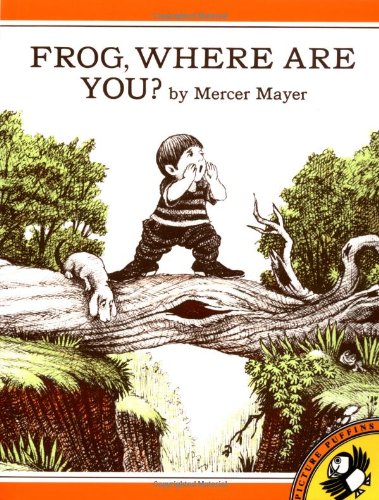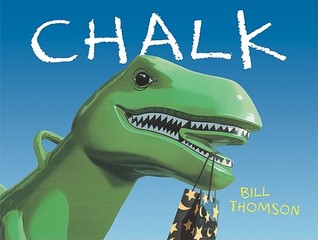 Today I am writing on one of my favorite topics: how to use wordless picture books for narrative assessment and treatment purposes in speech language pathology. I love wordless picture books (or WLPBs as I refer to them) for a good reason and its not just due to their cute illustrations. WLPBs are so flexible that use can use them for both assessment and treatment of narratives. I personally prefer the Mercer Meyer series: ‘A Boy, a dog, a frog and a friend’ for sentimental reasons (they were the first WLPBs I used in grad school) but some of you may want to use a few others which is why I’ll be proving a few links containing lists of select picture books for you to choose from at the end of this post.
Today I am writing on one of my favorite topics: how to use wordless picture books for narrative assessment and treatment purposes in speech language pathology. I love wordless picture books (or WLPBs as I refer to them) for a good reason and its not just due to their cute illustrations. WLPBs are so flexible that use can use them for both assessment and treatment of narratives. I personally prefer the Mercer Meyer series: ‘A Boy, a dog, a frog and a friend’ for sentimental reasons (they were the first WLPBs I used in grad school) but some of you may want to use a few others which is why I’ll be proving a few links containing lists of select picture books for you to choose from at the end of this post.

So how do I use them and with which age groups? Well, believe it or not you can start using them pretty early with toddlers and go all the way through upper elementary years. For myself, I found them to be most effective tools for children between 3-9 years of age. During comprehensive language assessments I use WLPBs in the following way. First I read a script based on the book. Depending on which WLPBs you use you can actually find select scripts online instead of creating your own. For example, if you choose to use the “Frog Series” by Mercer Meyer, the folks at SALT SOFTWARE already done the job for you and you can find those scripts HERE in both English and Spanish with audio to boot.
After I read/play the script, I ask the child to retell the story (a modified version of dynamic narrative assessment if you will) to see what their narrative is like. I am also looking to see whether the child is utilizing story telling techniques appropriate for his/her age.

For example, I expect a child between 3-4 years of age to be able to tell a story which contains 3 story grammar components (e.g., Initiating event, Attempt or Action, Consequences), minimally interpret/predict events during story telling, use some pronouns along with references to the characters names as well as discuss the character’s facial expressions, body postures & feelings (utilize early perspective taking) (Hedberg & Westby, 1993 ). By the time the child reaches 7 years of age, I expect him/her to be able to tell a story utilizing 5+ story grammar elements along with a clear ending, which indicates a resolution of the story’s problem, have a well developed plot, characters and a clear sequence of events, as well as keep consistent perspective which focuses around an incident in a story (Hedberg & Westby, 1993 ).

Therefore as children retell their stories based on the book I am keeping an eye on the following elements (as relevant to the child’s age of course):
- Is the child’s story order adequate or all jumbled up?
- Is the child using relevant story details or providing the bare minimum before turning the page?
- How’s the child’s grammar? Are there errors, telegraphic speech or overuse of run-on sentences?
- Is the child using any temporal (first, then, after that) and cohesive markers (and, so, but, etc)?
- Is the child’s vocabulary adequate of immature for his/her age?
- Is there an excessive number of word-retrieval difficulties which interfere with story telling and subsequently its comprehension?
- Is the child’s story coherent and cohesive?
- Is the child utilizing any perspective taking vocabulary and inferring the characters, feeling, ideas, beliefs, and thoughts?
Yes all of the above can be gleaned from a one wordless picture book!

If my assessment reveals that the child’s ability to engage in story telling is impaired for his/her age and I initiate treatment and still continue to use WLPBs in therapy. Depending on the child’s deficits I focus on remediating either elements of macrostructure (use-story organization and cohesion), microstructure (content + form including grammar syntax and vocabulary) or both.
Here are a few examples of story prompts I use in treatment with WLBPs:
- What is happening in this picture?
- Why do you think?
- What are the characters doing?
- Who /what else do you see?
- Does it look like anything is missing from this picture?
- Let’s make up a sentence with __________ (this word)
- Let’s tell the story. You start:
- Once upon a time
- You can say ____ or you can say ______ (teaching synonyms)
- What would be the opposite of _______? (teaching antonyms)
- Do you know that _____(this word) has 2 meanings
- 1st meaning
- 2nd meaning
- Who is in this story?
- What do they do?
- How do they go together?
- How do you think s/he feels?
- Why?
- How do you know?
- What do you think s/he thinking?
- Why?
- What do you think s/he saying?
- Where is the story happening?
- Is this inside or outside?
- How do you know?
- Is this inside or outside?
- Did the characters visit different places in the story?
- Which ones?
- How many?
Here are the questions related to Story Sequencing

- What happens at the beginning of the story?
- How do we start a story?
- What happened second?
- What happened next?
- What happened after that?
- What happened last?
- What do we say at the end of a story?
- Was there trouble/problem in the story?
- What happened?
- Who fixed it?
- How did s/he fix it?
- Was there adventure in the story?
- If yes how did it start and end?
As the child advances his/her skills I attempt to engage them in more complex book interactions
- Compare and contrast story characters/items
- (e.g. objects/people/animals)
- Make predictions and inferences about what going to happen in the story
- Ask the child to problem solve the situation for the character
- What do you think he must do to…?
- Ask the child to state his/her likes and dislikes about the story or its characters
- Ask the child to tell the story back
- Based on Pictures
- Without Pictures
Wordless picture books are also terrific for teaching vocabulary of feelings and emotions
- Words related to thinking
- Know, think, remember, guess
- Words related to senses
- See, Hear, Watch, Feel
- Words related to personal wants
- Want, Need, Wish
- Words related to emotions and feelings
- Happy, Mad, Sad
- Words related to emotional behaviors
- Crying, Laughing, Frowning
So this is how I use wordless picture books for the purposes of assessment and therapy. I’d love to know how you use them?
Before I sign off here are a few WDPBs links for you, hope you like them!
- http://www.goodreads.com/shelf/show/wordless-picture-books
- http://nancykeane.com/rl/317.htm
- http://nerdybookclub.wordpress.com/2013/03/30/top-ten-wordless-picture-books-by-kristen-remenar/
Start having fun with your wordless picture books today!
Helpful Smart Speech Therapy Resources:
 Need a L
Need a L Today I am very excited to introduce to you my brand new product which has been long in the making. “Speech Language Assessment of Older Internationally Adopted Children”. In the past I have written a number of articles and blog posts as well as done a number of presentations on related topics. I finally decided that it’s a great time to put it all together and created this 65 slide presentation which succinctly explains how to assess speech language abilities of older Internationally Adopted (IA) Children.
Today I am very excited to introduce to you my brand new product which has been long in the making. “Speech Language Assessment of Older Internationally Adopted Children”. In the past I have written a number of articles and blog posts as well as done a number of presentations on related topics. I finally decided that it’s a great time to put it all together and created this 65 slide presentation which succinctly explains how to assess speech language abilities of older Internationally Adopted (IA) Children.
 Recently I did a giveaway of my preschool speech language assessment checklist on my blog. I had so much fun doing it, that I decided I can’t just stop there, so I am going to do a giveaway of my school aged checklist as well.
Recently I did a giveaway of my preschool speech language assessment checklist on my blog. I had so much fun doing it, that I decided I can’t just stop there, so I am going to do a giveaway of my school aged checklist as well. Today I am excited to tell you about another product in my assessment referral series:
Today I am excited to tell you about another product in my assessment referral series:  Last week I did a guest post for The Simply Speech Blog. In case you missed it, below I offer an explanation why targeted speech language assessments are so important, as well as list helpful resources that will aid you in speech language assessment preparation.
Last week I did a guest post for The Simply Speech Blog. In case you missed it, below I offer an explanation why targeted speech language assessments are so important, as well as list helpful resources that will aid you in speech language assessment preparation. Practice effect is the change in performance resulting from repeated testing. In other words if a test is given to the child too soon, then his/her performance may improve due to the practice effect (remembering the test items).
Practice effect is the change in performance resulting from repeated testing. In other words if a test is given to the child too soon, then his/her performance may improve due to the practice effect (remembering the test items). Inattentiveness, hyperactivity, and impulsivity are the most common presenting behavioral problems in at-risk children. This workshop will describe select speech language causes of hyperactivity and inattentiveness in children beyond the ADHD diagnosis, including traumatic brain injury, auditory processing disorders, severe language disorders, as well as social pragmatic language deficits.It will review case examples to illustrate the importance of differential diagnosis. Implications for assessment as well as the need for relevant referrals will be discussed.
Inattentiveness, hyperactivity, and impulsivity are the most common presenting behavioral problems in at-risk children. This workshop will describe select speech language causes of hyperactivity and inattentiveness in children beyond the ADHD diagnosis, including traumatic brain injury, auditory processing disorders, severe language disorders, as well as social pragmatic language deficits.It will review case examples to illustrate the importance of differential diagnosis. Implications for assessment as well as the need for relevant referrals will be discussed.